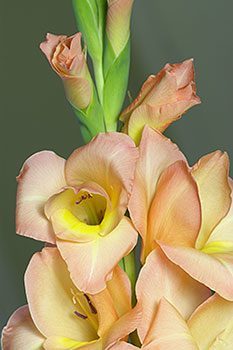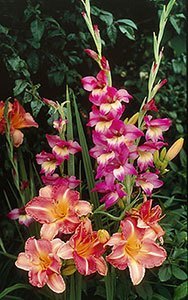Gladiola bulbs were once considered a bit old-fashioned, but like many old-fashioned flowers, they’re having a bit of a comeback.
I’m not a great fan of growing glads in the flower garden, but I do love them as cut flowers and always grow a couple of rows in the vegetable garden for that purpose.
Modern hybridization has given us glads in amazing variety. The flowers come in many colors, except true blue, and include numerous bi- and tri colors and even a chartreuse green.

Peach-color gladiola
The color of the corm will give you a hint to what the flower color will be.
If corms are dark or deep pink, the flowers will be dark fuchsia, violet or red. Light-colored corms produce flowers that are white, pale pink, yellow or greenish.
Gladiola bulbs for your garden
The plants produce impressive pointed stems with attractive funnel-shaped flowers that open from the base toward the top.
The leaves are narrow, straight and sword-shaped and appear very iris-like, as they belong to the iris family.
The most popular gladiola bulbs are the tall cultivars that grow just over three feet tall. However, there are a number of small-flowering gladioli belonging to the Nanus, Colvillei, Ramosus and Tubergenii groups, which reach heights ranging from 24 to 35 inches.
When buying gladiola bulbs, look for plump corms. Aside from your local garden center, reliable sources include specialty mail order and on-line suppliers.
Gladiola bulbs – how to grow
Glads grow well in most soil types without added fertilizer, but they need good drainage. Grow them in full sun and in a bed that gets good air circulation.

Gladiola in variety of colors
Plant after all danger of frost has passed; at about the time you would plant tomatoes. The soil should be warm, otherwise corms could rot.
Plant small corms about 2 to 3 inches deep, medium-sized ones 3 to 4 inches deep and large corms 4 to 6 inches deep. Space them about 6 inches apart, and to give you easy access for cutting, space rows 20 to 36 inches apart.
You can, of course, plant them in less regimented groupings in the flower garden, spacing each corm about 3 to 6 inches apart.
Gladiolus takes about eight to nine weeks to bloom after planting. If you plant a few each week from the end of May through to late June, you can be guaranteed cut flowers into the fall.
Stems are ready for cutting when the first flower has opened. Cut-flower glads have a vase-life of one to two weeks.
GLADIOLUS CARE TIPS
Watering: For best quality flowers, your glads should get an inch of water each week from rainfall or watering, if possible.
Insect control: Glad pests include thrips, tiny insects that can damage the foliage and flowers, especially in warm, dry summers. You can control them by spraying the plants with insecticidal soap weekly.
Storing over winter: Gladiola bulbs will come back year after year in regions where the ground does not freeze, but they are not winter-hardy in northern climates, so if you want to keep them going, dig them up after frost has blackened their leaves and store them in a frost-free place.
However, most experts advise buying new ones each year, as gladiola corms can be prone to damage from insects and fungal diseases.
If you decide to overwinter them, be sure to remove any remaining stem after it has dried up, and treat corms with a combination fungicide and insecticide dust.




